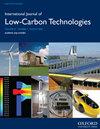尼日利亚六个选定地点能源系统优化利用的典型气象年数据分析
IF 2.3
4区 工程技术
Q3 ENERGY & FUELS
引用次数: 0
摘要
在这项研究中,使用桑迪亚方法生成并分析了代表尼日利亚6个地缘政治区的6个地点的典型气象年(TMY)数据。分析表明,所有选定地点都存在季节变化,这表明有两个不同的季节:旱季和雨季,从该国北部到南部的长度各不相同。由于其高全球辐射水平(21-25 MJ/m2/天),北方是太阳能热系统的理想位置。此外,今年前三个月经历的高月平均温度变化(约18°C)、低相对湿度(15%)和恒定风速(4m/s)有助于安装风能系统和应用蒸发冷却技术,从而降低建筑物的热负荷和能耗。另一方面,西南、东南和南南地区几乎全年的高相对湿度(80%)和中等辐射值阻碍了蒸发冷却和太阳能系统在这些地区的广泛应用,但是在一年的前三个月之间,与这些区域相关的中等风速(2.9m/s)和月平均温度变化允许应用自然通风和一些被动冷却系统,以减少这些区域中建筑物的热负荷。这项工作中提供的信息可以作为尼日利亚能源系统的设计和选择以及能源相关项目应用的指南。本文章由计算机程序翻译,如有差异,请以英文原文为准。
Typical Meteorological Year Data Analysis for Optimal Utilization of Energy Systems at Six Selected Locations in Nigeria
In this study, the Typical Meteorological Year (TMY) data for six locations representing the 6 geo-political zones in Nigeria were generated and analyzed using the Sandia Method. The analysis shows that seasonal variations exist in all the selected locations indicating two distinct seasons: the dry and wet seasons with varying lengths from north to south of the country. Due to its high global radiation levels (21–25 MJ/m2/day), the North is a desirable location for solar-thermal systems. Also, the high monthly mean temperature variations (about 18°C), low relative humidity (15%) and constant wind speeds (4m/s) experienced in the first three months of the year aid the installation of wind energy systems and the application of evaporative cooling techniques that reduce the thermal load and energy consumption of buildings. On the other side, the high relative humidity (80%) and mediocre radiation values derived almost throughout the year in the South-west, South-east and South-south regions discourages the extensive application of evaporative cooling and solar energy based systems in such locations, but the moderate wind speeds (2.9 m/s) and monthly mean temperature variations associated with these regions between the first three months of the year allow for the application of natural ventilation and some passive cooling systems so as to reduce the thermal load of buildings in the regions. The information presented in this work can serve as a guide for design and selection of energy systems and application of energy-related projects in Nigeria.
求助全文
通过发布文献求助,成功后即可免费获取论文全文。
去求助
来源期刊

International Journal of Low-carbon Technologies
Engineering-Architecture
CiteScore
4.30
自引率
4.30%
发文量
106
审稿时长
27 weeks
期刊介绍:
The International Journal of Low-Carbon Technologies is a quarterly publication concerned with the challenge of climate change and its effects on the built environment and sustainability. The Journal publishes original, quality research papers on issues of climate change, sustainable development and the built environment related to architecture, building services engineering, civil engineering, building engineering, urban design and other disciplines. It features in-depth articles, technical notes, review papers, book reviews and special issues devoted to international conferences. The journal encourages submissions related to interdisciplinary research in the built environment. The journal is available in paper and electronic formats. All articles are peer-reviewed by leading experts in the field.
 求助内容:
求助内容: 应助结果提醒方式:
应助结果提醒方式:


